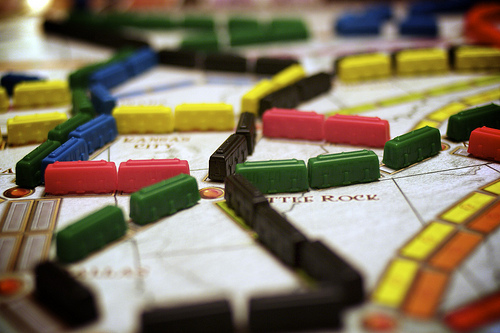The Neoclassics: Ticket to Ride
We talk a lot about games here at The Cardboard Republic. It’s sort of what we do. We also talk a lot about certain types of games, because, well, there are quite a few different styles. What makes games great is that regardless of your play style or your thematic preferences, there is a game for you out there. Maybe you prefer narrative-drive games, or you like games with puzzles. Perhaps you seek games that reward deep methodical strategies, or instead you gravitate towards those that reward player interaction over complicated rules.
There is a game that caters to your preference out there. We promise. But for many people, they aren’t even aware that new and unique board games continue to be made. Really. To many, the board game world persists as mere derivatives of Candy Land, Monopoly, Risk, or Cribbage. Trying to break people out of that mindset usually involves taking them out of their luck-centric game universe with a Gateway Game. Once such game is Ticket to Ride: the colored train car placement game.
It’s quick, it’s simple, and it’s been wildly successful during its lifespan. It’s spun off multiple other games, it’s available in digital formats, and it has easily earned its place in the Gateway Game pantheon. Ticket to Ride is not a game you can only get by stumbling upon it in some yard sale. No, compared even to most board games, Ticket to Ride is everywhere – and with good reason. The thing is, it’s also been talked about at great length from many perspectives. For a game that boasts how it can be taught in less than five minutes (which is actually true), it’s been – literally – reviewed the world over.
But it just doesn’t feel right to say nothing about the game that proved that board games with iconic, broad-based appeal could come from outside Europe.
We’ve decided to take a different tack. There are a number of games out there that are far newer than the “Classics” of the genre (Chess, Monopoly, Risk, Scrabble…) that have, in a manner of speaking, become the new staples. Ticket to Ride is one of course, but this also includes others such as Settlers of Catan, Carcassonne, and Puerto Rico. These are the “Neo-Classics”, those well-received and easily teachable games that board gamers have gravitated towards since they came out. We may not play them as much as our collections grow, but just as no family game shelf twenty or thirty years ago was complete without Scrabble, these are the games that we consider a necessary occupant on our shelf, especially where newcomers are concerned.
We would give these regular reviews, but not only are most people already familiar with them, they are already commercial successes. Instead, we’ll look at why they’ve done so well. What mechanics drew us in, what part of the design appealed to us? Do they still hold up today, or were they too more products of their time that have been outgrown?
The Inception
Ticket to Ride was released in 2004 under a then-fledgling family-oriented gaming company called Days of Wonder. The company was founded with the desire to make great board games while creating digital formats of them at the same time. They believed that having digital versions would reach a new audience and help spread interest in the games. In the summer of 2003 they met up with Alan R. Moon, a long-time game designer and industry veteran whose portfolio included an award-winning success in 1998 with a game called Elfenland and four award-nominated games the few years after that. Here Days of Wonder was shown Alan’s prototype of a train game called Station to Station. They were hooked after less than one playthrough. The following year it was released to the public, quickly winning awards and the admiration of gamers near and far. It picked up steam from there, and it hasn’t looked back.
The Rules
One of the hallmarks about the rules to Ticket to Ride is how quickly the game can be taught. Ticket to Ride is played on a map of the United States that has a number of colored track lines between cities. Each player receives a handful of cards with train cars on them, as well as a couple Destination tickets. A row of train cars are laid out next to the board. The player’s goal of the game is to complete routes between cities, and ultimately, to create a complete path between the two cities on their Destination tickets.
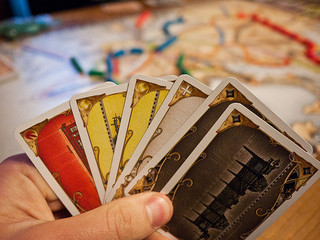 Each player’s turn consists of taking one of only three possible actions: draw train cars, claim a route, or draw new Destination tickets. If a player draws train cars, they choose up to two from the face-up row (only one if a Locomotive), or they can take blind draws from the deck. Cards taken from the row are replaced.
Each player’s turn consists of taking one of only three possible actions: draw train cars, claim a route, or draw new Destination tickets. If a player draws train cars, they choose up to two from the face-up row (only one if a Locomotive), or they can take blind draws from the deck. Cards taken from the row are replaced.
To claim a route, a player must discard the appropriate number of colored train cards required for that route segment and place their train pieces on that track. If the track is grey, any color is acceptable, so long as they are all the same. Locomotives act as wild cards.
Drawing new Destination tickets lets a player draw and keep between one and three new Destination tickets to work towards if they’ve already completed their current ones.
The goal of the game is to end with the most points. Laying track and completing Destination tickets net players positive points, while incomplete Destination tickets subtract their amount from the total.
Nearly A Decade of Steaming Along
Ticket to Ride won the coveted Spiel des Jahres award the year it came out, but that means little to someone who isn’t a huge gaming enthusiast. Your non-gamer friend or your grandmother probably won’t get excited about that. Even your average gamer may not recognize the title. It is clearly not prestige that precipitated Ticket to Ride’s rise to fame. So, then, what is it about this color-matching train game that keeps finding new converts?
- Simplicity: It’s true, Ticket to Ride is a very easy game to learn. It’s not Candy Land simple since you still have actual choices to make, but as far as simple goes, if you know numbers and colors, you can play Ticket to Ride. For some, this will decrease their interest in the game over time, but for others it’s a big selling point. Maybe you have a mixed company of players but you don’t have the numbers for (or don’t want to) dip into party game territory. Maybe you just finished a complicated game and you want something a little less think-y. Maybe you just want something simple because people present – like kids – don’t have the time or attention span of something more robust. Ticket to Ride’s simplicity here is actually more of an asset than a liability because it offers player choices without too many other things to focus on.
- Accessibility: Gateway Games need to have a few things going for them to be successful, and one of the most important ones is that it has to be inviting to new players. Gateways are rarely known for having oodles of theme, and that’s because having a rich theme tends to also include complexity. (Sorry Immersionists). Complexity ups the barrier to entry to the game-o-sphere. Instead, Gateway Games generally use just enough theme to provide a flavorful setting while still being a bit vague on the details. Ticket to Ride does that as well. You’re playing with trains, trying to link cities together. Most people like trains. Or, at least, most people don’t hate trains. Therefore, its odds of catching the attention of a wide audience are higher than, say, a zombie game or one set in Middle-Earth. As far as settings go, trains are a pretty safe choice.
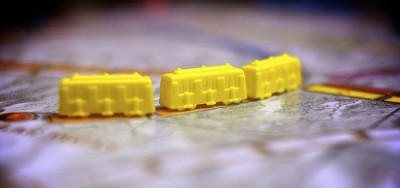 Replayability: Even with the mechanics of the game capable of being explained to you in a good 90 seconds, there is something addicting about the simple act of collecting cards of the same color, and then using them to put down your little train pieces on the board. Ticket to Ride possesses a certain elegance by honing in on that aspect. Part of that ties into our human nature to complete patterns: “I have three Yellow cards, and I need to get one more…”. Part of it is also visual: the Ticket to Ride board looks more appealing the more it fills up. Because these traits are felt irrespective of play style or the age of the player, there’s a greater volume of people willing to play it again. And it’s certainly possible to do so, because the game is also relatively short.
Replayability: Even with the mechanics of the game capable of being explained to you in a good 90 seconds, there is something addicting about the simple act of collecting cards of the same color, and then using them to put down your little train pieces on the board. Ticket to Ride possesses a certain elegance by honing in on that aspect. Part of that ties into our human nature to complete patterns: “I have three Yellow cards, and I need to get one more…”. Part of it is also visual: the Ticket to Ride board looks more appealing the more it fills up. Because these traits are felt irrespective of play style or the age of the player, there’s a greater volume of people willing to play it again. And it’s certainly possible to do so, because the game is also relatively short.- “Friendly” Play: A lot of the games people grew up with prior to the Era of Catan are pretty confrontational. Risk and Monopoly demand complete elimination of other players. Sorry! and Mouse Trap force confrontation. It’s no wonder that so many people as adults are dismissive of board games – too many memories ranging from boredom to frustration. Ticket to Ride focuses more on the individual players working towards their own goals rather than intentionally messing with their opponents. It is not devoid of conflict should you choose it, however. Players can take specific routes to delay or block others from completing routes, and it is considered a legitimate tactic in trying to stop someone in the lead. In general though, it’s pretty congenial, with players rushing to complete their own objectives.
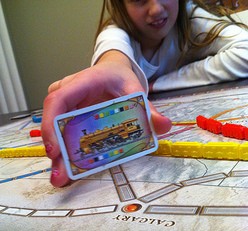 Luck: To many gamers, luck is a bad word. Luck means randomness, chance, chaos. Luck means you don’t have total control over your actions. Unless all players are on the same level of experience with each other, though, a game with little luck is usually one-sided. It brings down the enjoyment during the game, and it lessens the desire to play again. Luck is the great equalizer of board games, allowing everyone similar opportunities. Gateway Games help expose people to games where luck exists in far less quantities than the traditional classics, offering them more choices in their turns. You don’t want to overload them with too many options, however, and so luck is still quite useful here. That said, aside from the Destination cards and which train cards get flipped, Ticket to Ride actually offers comparatively less luck than other Gateway Games out there.
Luck: To many gamers, luck is a bad word. Luck means randomness, chance, chaos. Luck means you don’t have total control over your actions. Unless all players are on the same level of experience with each other, though, a game with little luck is usually one-sided. It brings down the enjoyment during the game, and it lessens the desire to play again. Luck is the great equalizer of board games, allowing everyone similar opportunities. Gateway Games help expose people to games where luck exists in far less quantities than the traditional classics, offering them more choices in their turns. You don’t want to overload them with too many options, however, and so luck is still quite useful here. That said, aside from the Destination cards and which train cards get flipped, Ticket to Ride actually offers comparatively less luck than other Gateway Games out there.- Lack of Inactivity: Do you remember Risk when it wasn’t your turn? It’s boring. Doubly so if two players start a massive battle. A lot of games have that issue, but in a Gateway Game, minimizing downtime is important. Now, Ticket to Ride doesn’t have actions you can take during other people’s turns, like, say, Settlers of Catan. Instead, the turns are very short. You can either pick up cards or put down trains. Once the game gets going and players know what they’re working towards, turns can last seconds. This turnaround time doesn’t give you a chance to get bored, because before you know it, it’s your turn again. This keeps the game moving while still being fun, making it the type of game Socializers gravitate towards.
The Legacy
Ticket to Ride’s influence has spread quickly in the years since release, spawning an entire series of Ticket to Ride games. If traveling the USA isn’t your thing, how about bouncing around Europe? Explore the Nordic Countries. Add in extra variables while moving around Germany. You can get additional map scenarios where players compete in places like the Swiss Alps, or the Great Silk Road. Each of them add their own little twists on the game, but they all invariably maintain the same Ticket to Ride feeling.
Ticket to Ride is not the type of game you want if you’re seeking something highly cerebral with deep decision-making choices. But that wasn’t its intent. Instead, its lighthearted rules and disarming atmosphere makes it ideal if you’re looking for something that can be played with a wide age range, or a wide variety of player skills. It has a simple premise, an inviting theme, and it provides just that right amount of luck vs skill that solidifies its title as a solid Gateway Game. When people often ask “What’s a good game to play?” with a group that contains novice or non-gamers, Ticket to Ride is often one of the first answers. What’s more, as with many Gateway Games, it serves as a good litmus test to determine where a newly-minted gamer should head afterwards.
Ticket to Tide continues to find new fans and its influence continues to grow, so there is little fear of it wearing out its excitement anytime soon – in part because one of the things it does so well is bring new people in to the hobby in a way that few games can. In time, it’s possible that it could help redefine the public’s definition of what a board game is, releasing Monopoly & Co. from their long overdue burden. And we’d be fine with that.
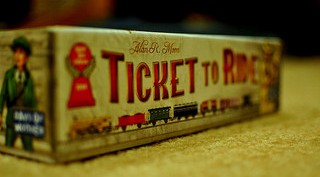
Photo Credits: TTR Board and Yellow Cars by Hollie Butler; Train Cards by Todd Page; Locomotive Card by marquiscote; TTR Box by Allan Kwan.

